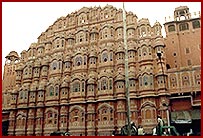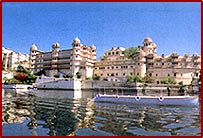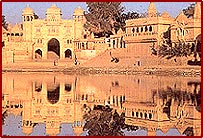

 Introduction: The royal land of Kings & Queens, sun
kissed desert, mystic forts and glorious palaces invites you for a mesmerizing
journey. The state is a hilly and rugged region which extends across the border
to Pakistan. Rajasthan with its inexhaustible historical wealth and brilliant
architecture is an unparalleled destination on the tourist map of India. It
showcases the spectacular fortess city Jodhpur at the edge of the Thar Desert,
golden city Jaisalmer with enchanting sand dunes and Bikaner the royal walled
city encompassing a medieval aura.
Introduction: The royal land of Kings & Queens, sun
kissed desert, mystic forts and glorious palaces invites you for a mesmerizing
journey. The state is a hilly and rugged region which extends across the border
to Pakistan. Rajasthan with its inexhaustible historical wealth and brilliant
architecture is an unparalleled destination on the tourist map of India. It
showcases the spectacular fortess city Jodhpur at the edge of the Thar Desert,
golden city Jaisalmer with enchanting sand dunes and Bikaner the royal walled
city encompassing a medieval aura.  Jaipur: Jaipur the vibrant capital of Rajasthan is popularly known as
the ‘Pink City’ because of the pink coloured buildings in its old city. This old
city of Jaipur is encircled with 7 gates, amongst which the major are Chandpol,
Sanganeri and Ajmeri. This city was made to order by Jai Singh in 1727 when
Mughal power the wane. The architect ‘Vidhyadhar Bhattacharya’ used the
principles of town planning the Shilpa Shastra, while designing the city. The
magical glow of the pink and orange building during sunset and the gorgeously
Rajasthani attires add beauty to this colourful city.
Jaipur: Jaipur the vibrant capital of Rajasthan is popularly known as
the ‘Pink City’ because of the pink coloured buildings in its old city. This old
city of Jaipur is encircled with 7 gates, amongst which the major are Chandpol,
Sanganeri and Ajmeri. This city was made to order by Jai Singh in 1727 when
Mughal power the wane. The architect ‘Vidhyadhar Bhattacharya’ used the
principles of town planning the Shilpa Shastra, while designing the city. The
magical glow of the pink and orange building during sunset and the gorgeously
Rajasthani attires add beauty to this colourful city. Udaipur: This place is a
symbol of romance, the most appealing place for poets, painters, travellers and
writers. Udaipur means the City of Dawn. It was founded in 1568 by Maharana Udai
Singh II. Udaipur is better known as the City of lakes. The marble palaces, the
beautiful gardens and the placid blue lakes enhance the beauty of this
city.
Udaipur: This place is a
symbol of romance, the most appealing place for poets, painters, travellers and
writers. Udaipur means the City of Dawn. It was founded in 1568 by Maharana Udai
Singh II. Udaipur is better known as the City of lakes. The marble palaces, the
beautiful gardens and the placid blue lakes enhance the beauty of this
city. Jaisalmer: The amazing little town seems to be
the last outpost of the Thar Desert like an Oasis full of life and colour.
Jaisalmer was founded in 1156 AD by Rawal Jaisal. The city is dotted with
havelis (mansions), palaces and temples made of intricately carved yellow
sandstone making it an architectural splendour.
Jaisalmer: The amazing little town seems to be
the last outpost of the Thar Desert like an Oasis full of life and colour.
Jaisalmer was founded in 1156 AD by Rawal Jaisal. The city is dotted with
havelis (mansions), palaces and temples made of intricately carved yellow
sandstone making it an architectural splendour.  Ajmer: Located in the state of Rajasthan , t offers a number
of ancient monuments that date back to time immemorial. The city was founded by
Raja Ajai Pal Chauhan in 7th Century. When Prithiviraj Chauhan lost it to
Mohammed Ghauri. Since then Ajmer became home to many dynasties. The city is an
amalgam of various cultures and a blend of Hinduism and Islam. Ajmer today is a
popular pilgrimage centre. Ajmer is also the base for visiting
Pushkar.
Ajmer: Located in the state of Rajasthan , t offers a number
of ancient monuments that date back to time immemorial. The city was founded by
Raja Ajai Pal Chauhan in 7th Century. When Prithiviraj Chauhan lost it to
Mohammed Ghauri. Since then Ajmer became home to many dynasties. The city is an
amalgam of various cultures and a blend of Hinduism and Islam. Ajmer today is a
popular pilgrimage centre. Ajmer is also the base for visiting
Pushkar. ight
Seeing: Savitri Temple and Man Mahal are the
places to visit.
ight
Seeing: Savitri Temple and Man Mahal are the
places to visit.
| Home | About Us | General Info |
Contact |
E-mail
| Query
| Site Map |
| ||||
|
|